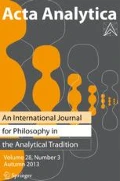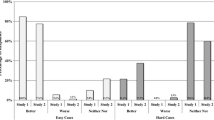Abstract
According to a standard picture, for any two comparable objects and a basis for comparison, either one is greater than the other or they are equal with respect to the basis. This picture has been called the Trichotomy Thesis, and although it is intuitive and plausible, it has been called into question by such philosophers as Derek Parfit, James Griffin, Joseph Raz, and Ruth Chang. Chang’s discussion is particularly rich, for she proposes and provides a detailed account of a possible fourth relation that, she argues, provides a satisfying explanation of hard cases of comparison. In this paper, I will examine a version of the main argument against the Trichotomy Thesis and attempt to show that it is unsound.
Similar content being viewed by others
Notes
The thesis that creativity is affected in a straightforward a manner by the number of creations the artist has produced is dubious. Although I have produced thousands of drawings, I can only draw one thing, and almost all of my drawings are of that one thing. I am not very creative with respect to drawing, even though I am very productive. In general, increasing productivity does not directly increase creativity.
Parfit’s argument concerns the relative merits of three candidates for a literary prize: Poet1, Poet2, and Novelist. Poet1 is neither better nor worse than Novelist with respect to literary merit, and Poet2 is slightly better than Poet1 (See Parfit, p. 431). Parfit claims that this relationship of equality violates an intuitively plausible principle of transitivity: that Poet2 is slightly better than Poet1 while Poet1 is neither better nor worse than Novelist seems as though it would entail that Poet2 is slightly better than Novelist, but it does not, because judgments of literary merit are insufficiently precise. Another case, due to Joseph Raz, concerns a choice between two careers: being a lawyer, and being a professional hang-glider (see Raz 1986, p. 325; sometimes “clarinetist” is the second career in the example). The law career would be more financially rewarding, but at the cost of long hours, lots of schooling, and many dull days spent poring over law books. The hang-gliding career would contain more excitement, a more flexible schedule, and would permit more time for extracurricular pursuits, but at the cost of financial security and risk to life and limb. Although the hang-gliding career is better in certain respects than the career in law, and the career in law may be better in other respects, but perhaps neither is better than the other simpliciter, and we are asked to fill in the details in such a way as to make it as plausible as possible that this is the case. There is a similar failure of transitivity: adding $1,000 to the annual salary of the hang-gliding career seems to be sufficient to make it better as a career than it previously was, but insufficient to make it better than the career in law. Other examples concern the impressiveness of Stonehenge and Salisbury Cathedral (see Broome 1997a; p. 68) and the relative potential for future quality of research of two philosophy job candidates (see Chang 2002).
Chang also devotes space to showing that Michelangelo and Mozart are comparable with respect to creativity. I am inclined to suspect that if any two things are comparable with respect to creativity, Michelangelo and Mozart are, so I will not discuss her argument in detail.
The other cases are similarly poorly described. In the career case we are told only which fields the careers are in and that they are “successful.” There are, however, many potentially relevant factors. What are their salaries? Their hours? Is there a lot of travel? Are the coworkers nice? Will there be time for family? Similar points can be made concerning the rest of the small-improvement examples.
Similar things might be said about the other small improvement cases: ‘literary merit’ tracks another extraordinarily complicated complex of features such that it clearly has no precise meaning, as does ‘goodness as a career.’
For helpful comments and discussion, I would like to thank Jacob Bridge, Phillip Bricker, Fred Feldman, Kris McDaniel, Alex Sarch, and an audience at Western Washington University.
References
Broome. (1997a). Is incommensurability vagueness? In Chang. pp. 67–89
Chang, R. (1997). Introduction. In Chang (Ed.), Incommensurability, incomparability, and practical reason. Cambridge, Mass: Harvard University Press.
Chang, R. (2002). The possibility of parity. Ethics, 112, 659–688.
Chang, R. (2005). Parity, interval value, and choice. Ethics, 115, 331–350.
de Sousa, R. (1974). The good and the true. Mind, 83, 534–551.
Ellis, B. (1966). Basic concepts of measurement. Cambridge: Cambridge University Press.
Espinoza, N. (2008). The small improvement argument. Synthese, vol. 165.
Gert, J. (2006). Value and parity. Ethics, 114, 492–510.
Griffin, J. (1986). Well-being: Its meaning, measurement and moral importance. Oxford University Press, pp. 81–92.
Hsieh, N. (2005). Equality, clumpiness, and incomparability. Utilitas, 17(2), 180–204.
Kagan, S. (1988). The additive fallacy. Ethics, 99, 5–31.
Krantz, D. H., Luce, R. D., Suppes, P., & Tversky, A. (1971). Foundations of measurement volume I. Dover: Dover Publishing.
Luce, R. D. & Raiffa, H. (1957). Games and decisions. New York: Wiley.
Moore, G. E. (1903). Principia ethica (p. 96). Cambridge: Cambridge University Press.
Mundy, B. (1987). The metaphysics of quantity. Philosophical Studies, 51, 29–54.
Parfit, D. (1984). Reasons and persons (p. 431). Oxford: Oxford University Press.
Raz, J. (1997). Incommensurability and agency. In R. Chang (Ed.), Incommensurability, incomparability, and practical reason (pp. 110–128). Cambridge, Mass: Harvard University Press.
Raz, J. (1985–86). Value incommensurability. Proceedings of the Aristotelian Society, 86, 117–134.
Raz, J. (1986). The morality of freedom, Chap. 13. Oxford: Clarendon Press.
Resnik, M. D. (1987). Choices. Minneapolis: University of Minnesota Press.
Sinnott-Armstrong, W. (1988). Moral dilemmas (p. 67). Oxford: Blackwell Press.
Stevens, S. S. (1946). On the theory of scales of measurement. Science, 103, 677–680.
von Neumann, J. & Morgenstern, O. (1944). Theory of games and economic behavior. Princeton: Princeton University Press.
Wasserman, R. (2004). Indeterminacy, ignorance, and the possibility of parity. Philosophical Perspectives, 18, 391–403.
Williamson, T. (2000). Knowledge and its limits (pp. 93–113). Oxford University Press: Oxford.
Author information
Authors and Affiliations
Corresponding author
Rights and permissions
About this article
Cite this article
Klocksiem, J. In Defense of the Trichotomy Thesis. Acta Anal 25, 317–327 (2010). https://doi.org/10.1007/s12136-009-0067-z
Received:
Accepted:
Published:
Issue Date:
DOI: https://doi.org/10.1007/s12136-009-0067-z



